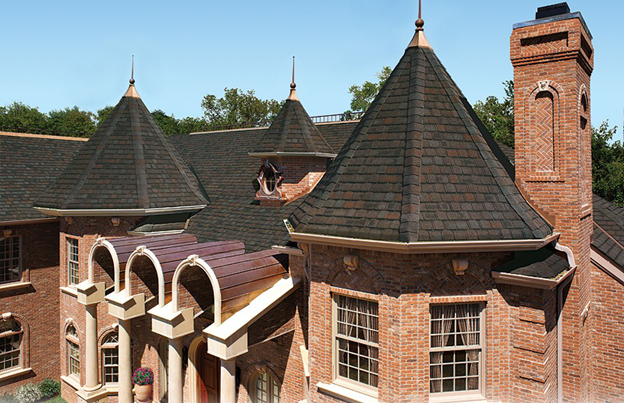Philadelphia, known as the cradle of American history, boasts an impressive collection of historic buildings. Each structure mirrors a unique blend of architectural styles, spanning various eras and cultural influences. A key feature of these venerable buildings is their roofing. The roofs of Philadelphia’s historic structures are more than mere protective covers; they are pivotal in defining the buildings’ aesthetic allure and are integral to their structural health. In this city, the restoration of historical roofs is an art form in itself. It demands a detailed, careful approach, often employing time-honored techniques and materials. This restoration work also requires a profound appreciation and understanding of architectural history, ensuring that each roof not only retains its historical accuracy but also contributes to the building’s longevity and narrative. In Philadelphia, the restoration of these historical roofs is not just a construction task—it’s a preservation of history itself.

The Significance of Roofing in Philadelphia’s Historic Buildings
Philadelphia, a city rich in history, is home to an array of historic buildings that boast a diverse assortment of roofing materials and styles, encapsulating everything from the elegant slate and tile to the more utilitarian metal and wood shingles. This variety in roofing is not a mere coincidence but a reflection of several key factors: the prevailing architectural trends of the era, the availability and accessibility of construction materials, and the socio-economic standing of the buildings’ original owners. For example, slate roofs, renowned for their long-lasting durability and excellent fire-resistant qualities, were a popular choice in the more affluent neighborhoods of Philadelphia. These high-end materials symbolized not only wealth but also a commitment to quality and longevity. On the other hand, wood shingles, more economical and readily available, were a common sight in areas where resources were more limited.
The roofs of these venerable buildings serve a purpose far beyond mere protection from weather elements. They are storytellers, narrating tales of Philadelphia’s historical journey, its connections in trade and commerce, and the evolution of building technologies over the years. Each roof, with its unique material and design, provides a glimpse into the past, offering insights into the lifestyle and priorities of the city’s inhabitants during different historical periods.
Moreover, the preservation of these roofs is not just about maintaining the aesthetic charm of Philadelphia’s skyline. It’s a vital aspect of conserving the historical authenticity and ensuring the structural integrity of the city’s cherished heritage buildings. These roofs are a testament to the craftsmanship and architectural wisdom of the past, and preserving them helps maintain the connection between present-day Philadelphia and its rich historical legacy. By safeguarding these historical structures and their distinctive roofs, the city honors its past, embraces its cultural heritage, and continues to educate future generations about the architectural and historical significance of these timeless landmarks.
Challenges in Historical Roof Restoration
The task of restoring the roofs of Philadelphia’s historic buildings is a complex and challenging endeavor. One of the primary difficulties lies in sourcing materials that match the originals. Over time, the manufacturing processes and available materials have evolved, resulting in contemporary materials that often differ significantly in appearance and quality from those used historically. For example, modern slate tiles may not replicate the unique color and texture of those crafted a century ago, presenting a significant challenge for restorers aiming for authenticity.
Another critical aspect of restoration is maintaining the historical integrity of the buildings. This requires a delicate balance between utilizing modern, more durable materials and staying faithful to the original designs and materials used. Achieving this balance often necessitates the custom fabrication of roofing materials, along with a profound understanding of historical building techniques. Restorers must work meticulously to ensure that any modern interventions are in harmony with the building’s historical character.
Furthermore, the restoration process is complicated by regulatory constraints. Philadelphia enforces stringent guidelines concerning the preservation of historic structures. Therefore, any restoration project must comply with these established standards, ensuring that the work is in line with the city’s commitment to preserving its historical heritage. Navigating these regulations demands not only expertise in the field of restoration but also often involves collaboration with preservation societies or local authorities. This collaboration is crucial to ensure that the restoration work honors the historical significance of the buildings while adhering to contemporary standards and regulations.
Techniques and Materials in Historical Roof Restoration
Historical roof restoration in Philadelphia involves a variety of specialized techniques and materials. Restorers often use hand tools to replicate the craftsmanship of the original builders. For instance, slate tiles might be hand-cut to match the size and shape of the originals. Similarly, metal roofs might require traditional soldering techniques rather than modern welding.
Materials play a crucial role in restoration. Wherever possible, original materials are salvaged and reused. When new materials are needed, restorers endeavor to source materials that are as close as possible to the original in terms of composition, color, and texture. This might involve sourcing reclaimed materials from other historical buildings or having custom materials fabricated.
Case Studies of Roof Restoration in Philadelphia
Philadelphia boasts a number of exemplary historical roof restoration projects that stand as testaments to the city’s dedication to preserving its architectural heritage. A prime instance of this commitment is seen in the restoration of Independence Hall’s roof. This iconic landmark underwent a meticulous restoration process, with specialists using materials and techniques that were true to the period, ensuring the roof’s appearance was authentically restored to its original state. Similarly, the Betsy Ross House is another shining example, where the cedar shingle roof was replaced with great care. This not only maintained the building’s distinctive colonial charm but also respected its historical significance.
These restoration endeavors underscore the critical role of thorough historical research and the application of expert craftsmanship. They demonstrate a profound dedication to safeguarding Philadelphia’s rich architectural legacy. By adhering closely to historical accuracy and employing skilled techniques, these projects help ensure that the city’s storied past continues to be celebrated and preserved for future generations.
The Role of Technology in Historical Roof Restoration
While traditional techniques and materials are essential in historical roof restoration, modern technology also plays a significant role. Advances in digital imaging and 3D printing have enabled restorers to accurately replicate architectural details that would be difficult to recreate by hand. Moreover, modern weatherproofing techniques and materials can be used to enhance the longevity of the roofs without compromising their historical appearance.
Economic and Cultural Impact of Roof Restoration
The restoration of historic roofs in Philadelphia carries immense economic and cultural value. This practice is key to maintaining the city’s rich architectural history and also acts as a catalyst for tourism, attracting visitors keen to explore Philadelphia’s historic charm. Economically, these restoration projects stimulate the local job market by creating employment opportunities for skilled craftsmen and artisans. These professionals are adept in traditional construction methods, ensuring that these historic restorations are both authentic and of high quality.
To Conclude
The task of restoring Philadelphia’s historic roofs is more than a mere preservation effort; it is a crucial undertaking that intertwines the past with the present. This process demands a nuanced balance between traditional methods and modern innovation, coupled with an extensive knowledge of historical building techniques. More importantly, it signifies a deep-seated commitment to preserving the authenticity of these revered buildings. As Philadelphia continues to grow and change, the careful preservation of its historic roofs allows future generations to connect with, appreciate, and learn from the city’s illustrious history.

